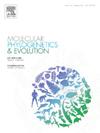Evolutionary dynamics and codon bias analysis of canine circovirus: Insights into global spread and host adaptability
IF 3.6
1区 生物学
Q2 BIOCHEMISTRY & MOLECULAR BIOLOGY
引用次数: 0
Abstract
Circoviruses are relatively new pathogens, and new circoviruses are constantly being discovered, with a growing range of hosts. Recently, canine circovirus (CanineCV) was reported to infect cats and badgers, further broadening its host range. Previous studies on the evolution and dissemination of CanineCV were fragmented. Here, when conducting a metagenomic analysis of shelter dogs, we identified a canine circovirus positivity rate of 32.4% and obtained three new viral strains. Furthermore, we integrated publicly available viral sequences and employed multiple bioinformatic software tools to analyze the evolution, codon usage bias, recombination, origin, spatiotemporal distribution and host adaptability of CanineCV. In this study, CanineCV could be divided into five distinct phylogenetic clades, named as China-I, China-II, Cosmopolitan, EA, and SEA clades. The extensive inter-clade recombination was observed, which plays an important role in viral evolution, while based on existing sequence information, CanineCV most likely originated in Norway from Vulpes vulpes in 1950.7. Notably, CanineCV exhibits greater adaptability to human hosts compared to previously documented hosts, as indicated by host adaptability indices, suggesting that this virus may possess zoonotic potential. In summary, our study elucidates the phylogeography and evolutionary dynamics of CanineCV and underscores the importance of investigating its potential for zoonotic transmission.

犬圆环病毒的进化动力学和密码子偏差分析:对全球传播和宿主适应性的见解
圆环病毒是相对较新的病原体,新的圆环病毒不断被发现,宿主的范围也在不断扩大。最近,犬圆环病毒(CanineCV)被报道感染猫和獾,进一步扩大了其宿主范围。以往关于犬ecv进化和传播的研究比较零散。在对收容犬进行宏基因组分析时,我们发现犬圆环病毒阳性率为32.4%,并获得了三种新的病毒株。此外,我们整合了公开的病毒序列,并利用多种生物信息学软件工具分析了CanineCV的进化、密码子使用偏好、重组、起源、时空分布和宿主适应性。本研究将犬ecv分为5个不同的进化支系,分别命名为China-I、China-II、Cosmopolitan、EA和SEA支系。观察到广泛的进化分支间重组,这在病毒进化中发挥了重要作用,而根据现有的序列信息,CanineCV很可能起源于1950年的挪威,来自Vulpes Vulpes。值得注意的是,与先前记录的宿主相比,犬ecv对人类宿主表现出更强的适应性,正如宿主适应性指数所示,这表明该病毒可能具有人畜共患的潜力。总之,我们的研究阐明了犬ecv的系统地理学和进化动力学,并强调了调查其人畜共患传播潜力的重要性。
本文章由计算机程序翻译,如有差异,请以英文原文为准。
求助全文
约1分钟内获得全文
求助全文
来源期刊
CiteScore
7.50
自引率
7.30%
发文量
249
审稿时长
7.5 months
期刊介绍:
Molecular Phylogenetics and Evolution is dedicated to bringing Darwin''s dream within grasp - to "have fairly true genealogical trees of each great kingdom of Nature." The journal provides a forum for molecular studies that advance our understanding of phylogeny and evolution, further the development of phylogenetically more accurate taxonomic classifications, and ultimately bring a unified classification for all the ramifying lines of life. Phylogeographic studies will be considered for publication if they offer EXCEPTIONAL theoretical or empirical advances.

 求助内容:
求助内容: 应助结果提醒方式:
应助结果提醒方式:


